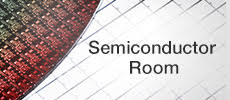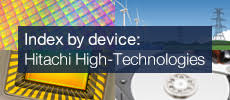
6. Semiconductor Power Devices and MEMS
~Recent noteworthy semiconductor devices~
"Power devices"

While semiconductors like the CPU and the LSI are used for computing and memory, power devices are used for electricity control and conversion. Speaking of semiconductor might imagine the IC. But power devices are semiconductors that can operate under large current and high voltage, in contrast to ICs. For example, the power circuit called an inverter that controls the electric power for running a train is embedded with power devices called a gate turn-off thyristor (GTO) and an insulated gate bipolar transistor (IGBT). These power devices turn the power on/off several hundred times to several tens of thousands times per second. In addition, these power devices can handle high voltage of several thousand volts, enabling the operation of the Shinkansen bullet train.
Inverters embedded with the efficient IGBT and other power devices are used in home appliances such as air conditioners, refrigerators, microwaves, rice cookers and LCD televisions, which are indispensable in our everyday live. They are also used in hybrid cars, fuel cells, solar cells and wind power generation, which are essential for taking measures against global warming. (Speaking of "inverter", it often refers to the entire device which combined with the converter.)
In recent years, SiC and GaN based wide-bandgap power semiconductors have been receiving much attention as the "Next Generation Power Semiconductors". Since these power semiconductors have significantly lower power loss compared to silicon based power devices, these new power devices can improve efficiency of the power supply and reduce the size of equipment. New power semiconductor materials are also expected to improve fuel efficiency of a hybrid car and to save energies of various devices including electric vehicles and trains. As the next generation power semiconductors are currently being commercialized, further improvements are expected in the performance of power electronics products.
"MEMS"

MEMS (Micro Electro Mechanical Systems) are ultra-compact systems composed of micro-mechanical components such as sensors, actuators and electronic circuits on a silicon wafer using the microfabrication technology of the LSI (semiconductor) manufacturing technology. MEMS contribute to the ultra-miniaturization of various products, for example digital micro-displays (DMD) of projectors, nozzles inside the heads of ink-jet printers and a variety of sensors such as gyroscopes, pressure sensors, acceleration sensors and flow rate sensors. They are also used in the blood test chips and catheters of medical devices.
In the conventional LSIs, electronic circuit is integrated large quantities on a wafer plane. On the other hand, most distinctive feature of MEMS is that it can be fabricated large quantities of mechanical devices on the wafer. The mechanical devices in MEMS are fabricated with using three-dimensional lamination techniques onto a wafer. The mechanical devices and electrical functions in MEMS are manufactured at the same time. This enables the enhancement of the high performance and large capacity of the LSI. In the future, MEMS will miniaturize sensors and other devices even further and make them even more efficient in terms of power consumption.
"In the future"
Power semiconductor devices and MEMS sensors will be utilized more and more on a variety of products, including smartphones and automobiles. More and more information will be processed at a lower power consumption, and it is expected the realization of safe, secure and smart society by the sensor network.


